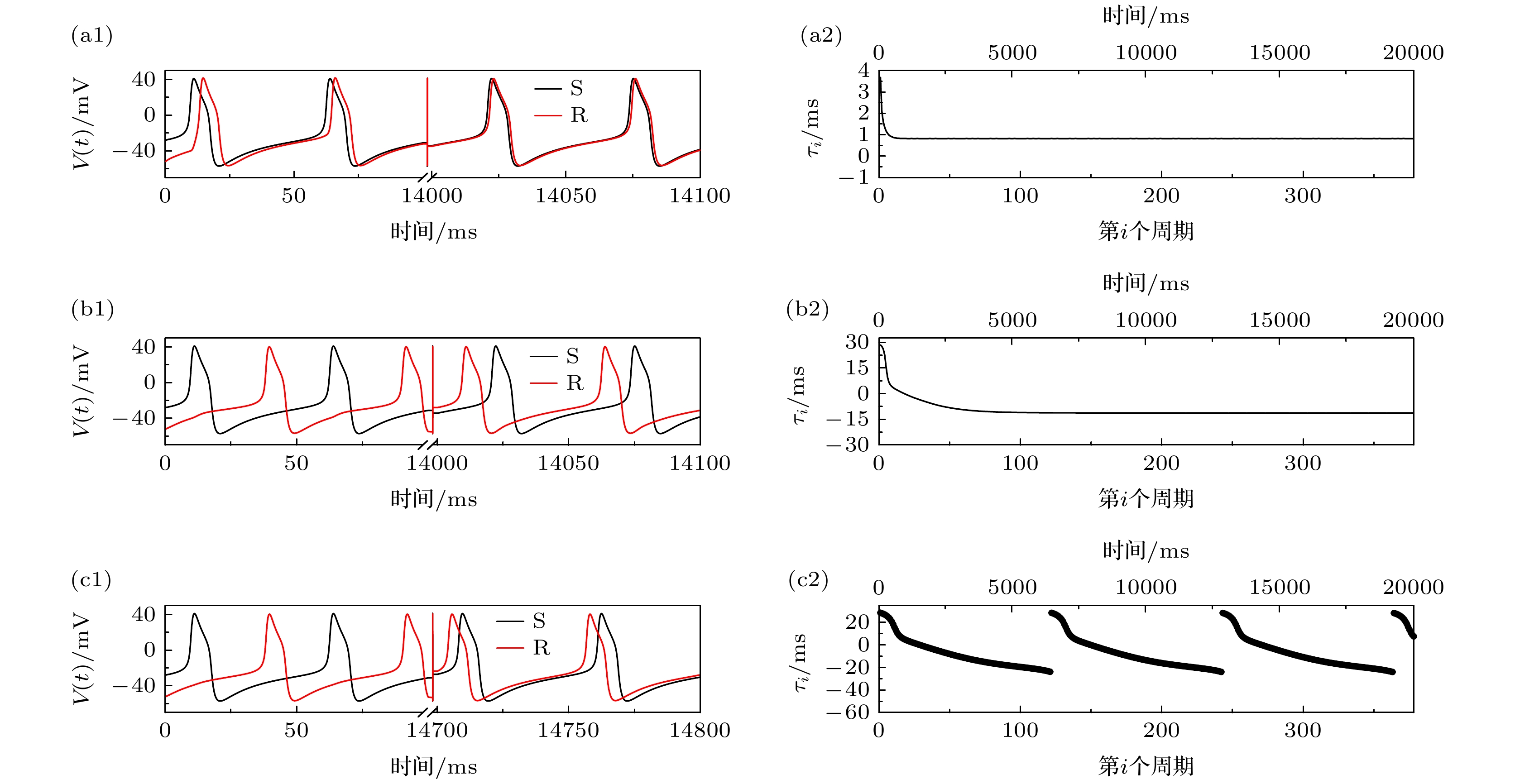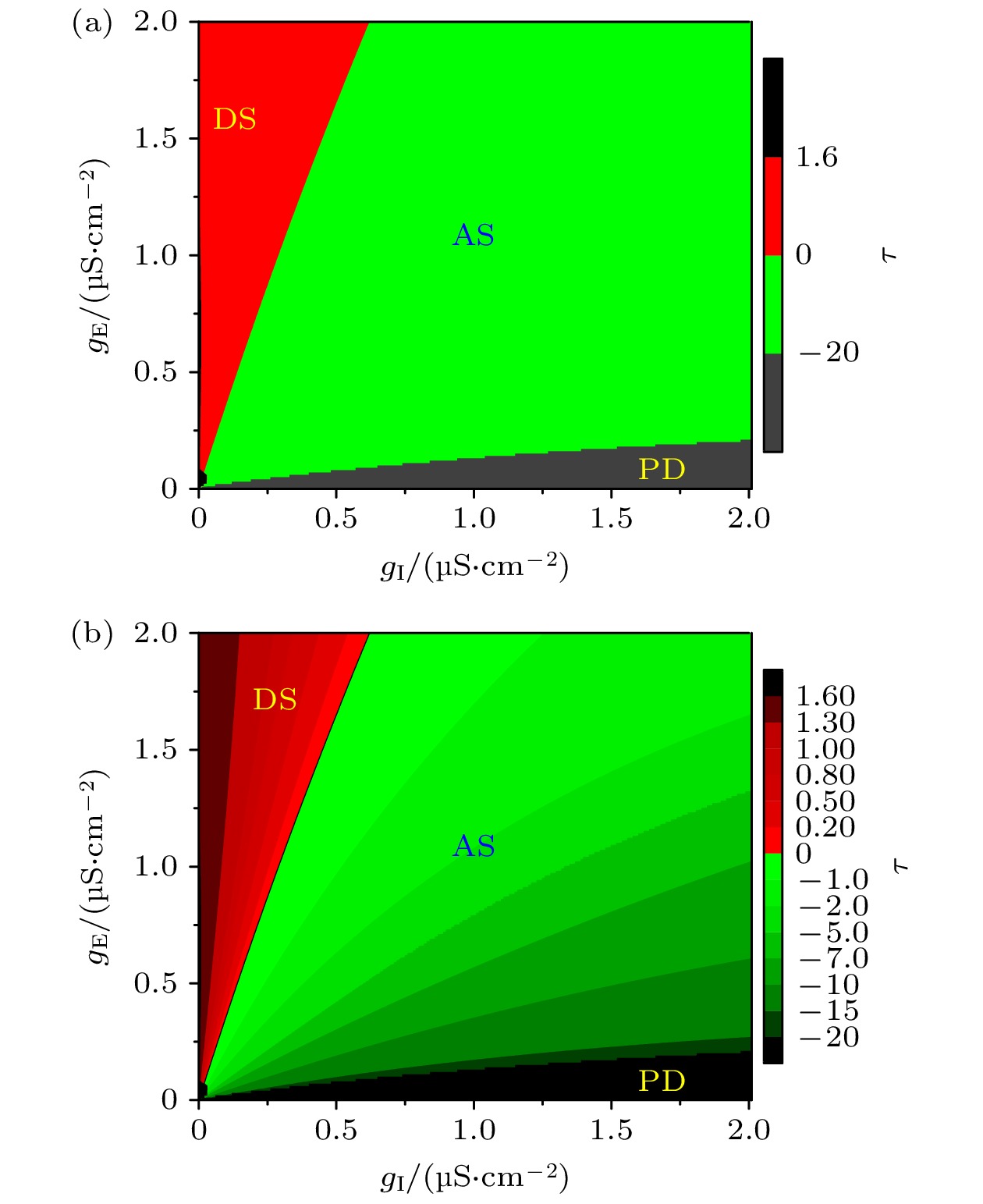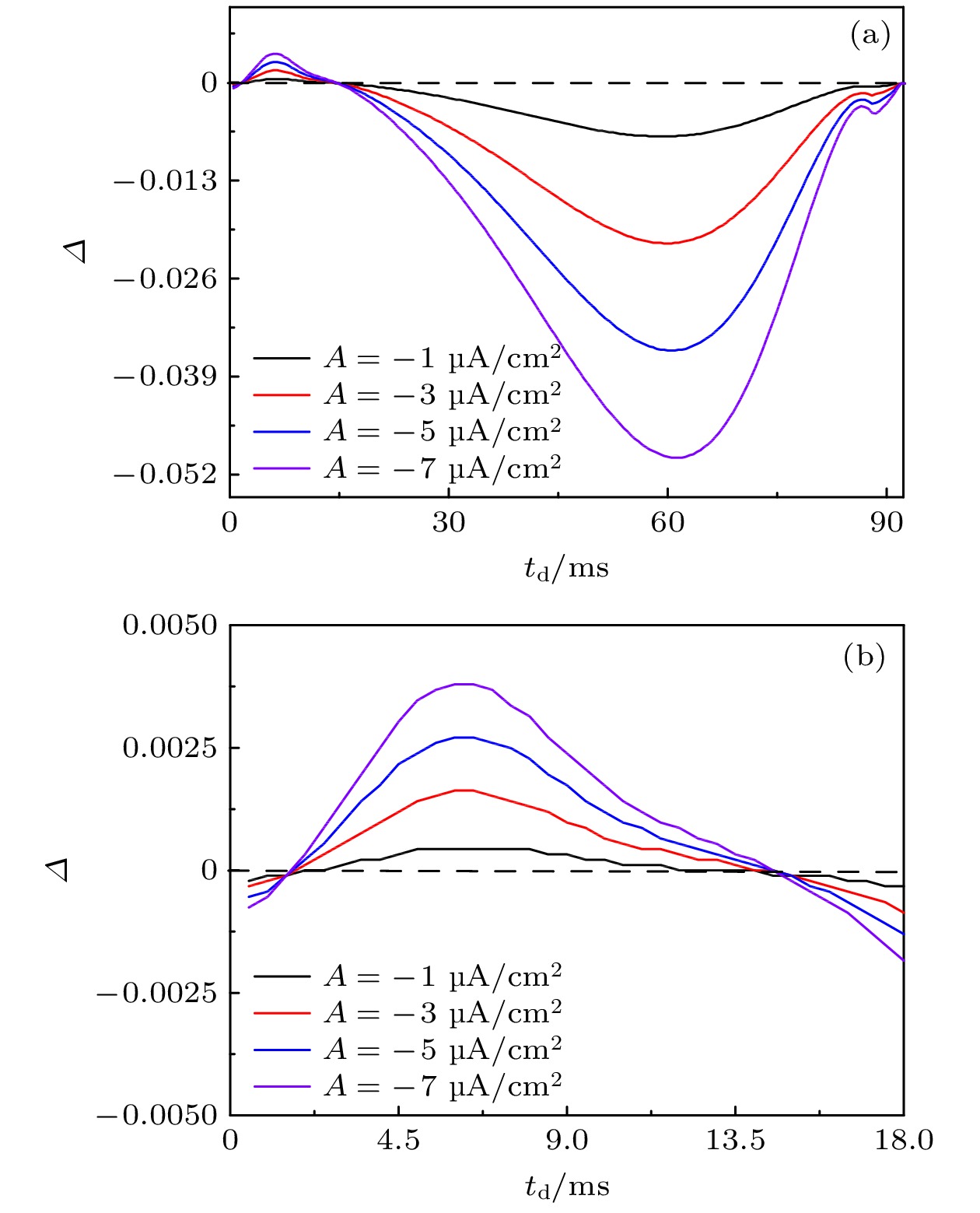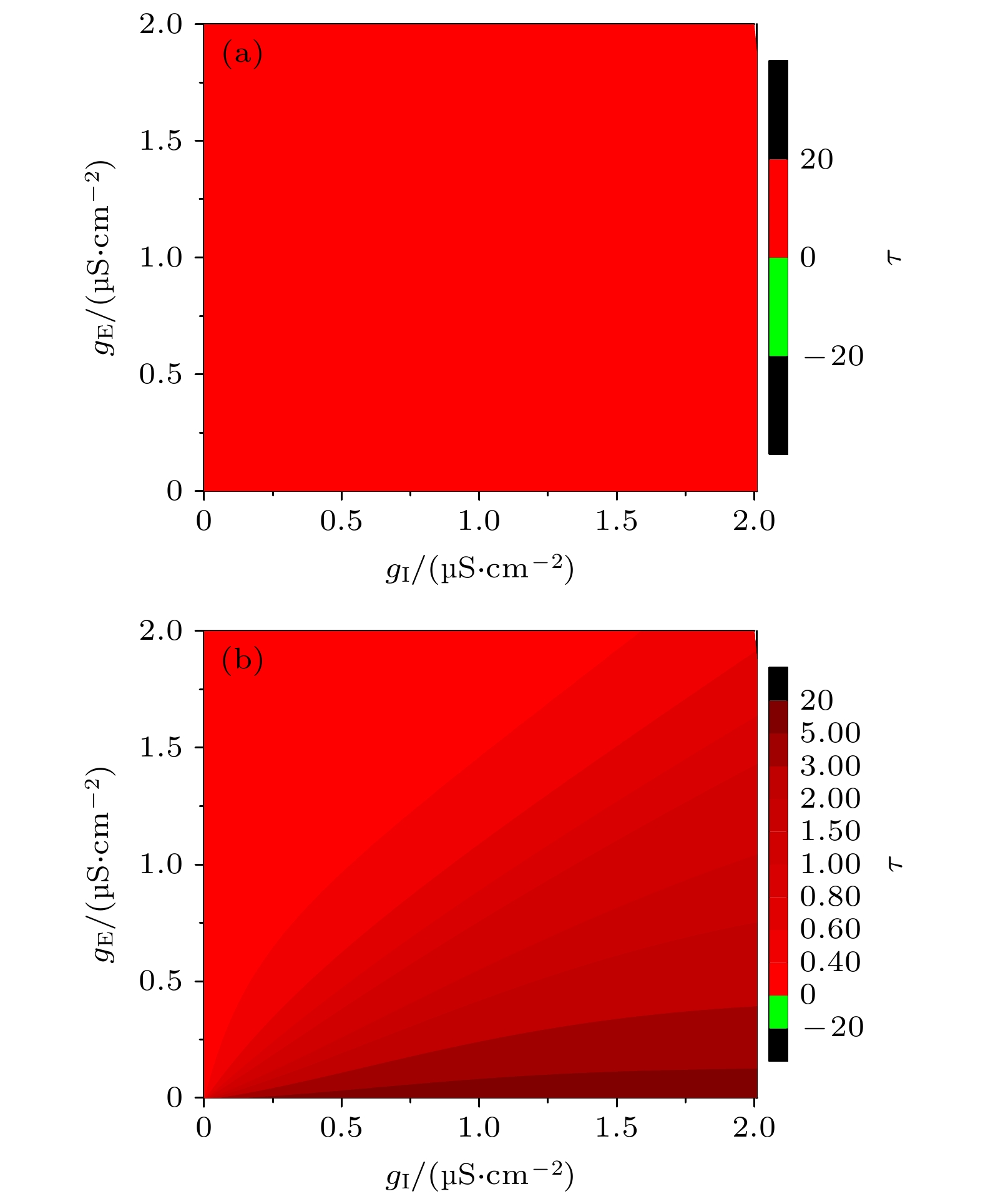-
Anticipated synchronization, the response of the driven subsystem which appears earlier than the stimulation from the driving subsystem, is a universally counterintuitive nonlinear behavior. This behavior is also observed in the experiment on the nervous system in different brain regions. In the present paper, the anticipated synchronization phenomenon evoked by the inhibitory autapse is simulated in the coupled system composed of Morris-Lecar model, and the condition of excitability of single neurons and parameter ranges for the anticipated synchronization is presented. For a coupled system composed of two neurons, whether both neurons are either type-I excitability/Hopf bifurcation or type-II excitability/saddle-node bifurcation on an invariant cycle, in a driven neuron unidirectionally receiving the excitatory synaptic current from a driving neuron the delayed synchronization (the response of the driven neuron appears after the drive of the driving neuron) instead of the anticipated synchronization is simulated. After the inhibitory autapse is introduced into the driven neuron, the anticipated synchronization can be simulated in the coupled neurons when both neurons are of type-II excitability. With the increase of the conductance of the inhibitory autapse, the transition from delayed synchronization to anticipated synchronization is simulated. The time interval between spike of the driving and driven neuron is acquired, and the parameter ranges of anticipated synchronization in the plane of conductance of the inhibitory autapse and excitatory synapse are obtained. However, if both neurons are of type-I excitability, only delayed synchronization is simulated for the driven neuron with inhibitory autapse. Furthermore, the appearance of anticipated synchronization for type-II neurons and no anticipated synchronization for type-I neurons are suggested to have a relationship between the different responses of firing to external inhibitory stimulation for neurons with type-II excitability and type-I excitability. For spiking of type-II neuron, when an inhibitory pulse stimulation is applied, the spike following the pulse appears earlier than the one in the absence of stimulation in a wide range of the stimulation phase. However, for spiking behavior of type-I excitability, the spike following an inhibitory pulse stimulation appears later than the spike in the absence of stimulation. The results present the condition of single neurons for the appearance of anticipated synchronization induced by the inhibitory self-feedback mediated by autapse, which is helpful for understanding the dynamics of the counter-intuitive behavior, anticipated synchronization, presenting possible measures to modulate the anticipated synchronization, and proving directions for further study of anticipated synchronization.
-
Keywords:
- anticipated synchronization /
- excitability /
- bifurcation /
- inhibitory autapse
[1] Boccaletti S, Kurths J, Osipov G, Valladares D L, Zhou C S 2002 Phys. Rep. 366 1
 Google Scholar
Google Scholar
[2] Izhikevich E M 2007 Dynamical Systems in Neuroscience: The Geometry of Excitability and Bursting (Cambridge: The MIT Press) pp301−348
[3] Voss H U 2000 Phys. Rev. E 61 5115
 Google Scholar
Google Scholar
[4] Yao C G, He Z W, Nakano T, Qian Y, Shuai J W 2019 Nonlinear Dyn. 97 1425
 Google Scholar
Google Scholar
[5] 丁学利, 贾冰, 李玉叶 2019 68 180502
 Google Scholar
Google Scholar
Ding X L, Jia B, Li Y Y 2019 Acta Phys. Sin. 68 180502
 Google Scholar
Google Scholar
[6] He Z W, Yao C G, Shuai J W, Nakano T 2020 Chin. Phys. B 29 128702
 Google Scholar
Google Scholar
[7] Wu F, Gu H 2020 Int. J. Bifurcat. Chaos 30 2030009
 Google Scholar
Google Scholar
[8] Zhao Z G, Li L, Gu H G 2020 Commun. Nonlinear Sci. Numer. Simulat. 85 105250
 Google Scholar
Google Scholar
[9] Voss H U 2001 Phys. Rev. Lett. 87 014102
 Google Scholar
Google Scholar
[10] Voss H U 2001 Phys. Rev. E 64 039904
 Google Scholar
Google Scholar
[11] Voss H U 2016 Phys. Rev. E 93 030201
 Google Scholar
Google Scholar
[12] Voss H U 2018 Chaos 28 113113
 Google Scholar
Google Scholar
[13] Tang S, Liu J M 2003 Phys. Rev. Lett. 90 194101
 Google Scholar
Google Scholar
[14] Ciszak M, Calvo O, Masoller C, Mirasso C R, Toral R 2003 Phys. Rev. Lett. 90 204102
 Google Scholar
Google Scholar
[15] Simonov A Y, Gordleeva S Y, Pisarchik A, Kazantsev V 2014 JETP Lett. 98 632
 Google Scholar
Google Scholar
[16] Matias F S, Carelli P V, Mirasso C R, Copelli M 2011 Phys. Rev. E 84 021922
 Google Scholar
Google Scholar
[17] Matias F S, Gollo L L, Carelli P V, Mirasso C R, Copelli M 2016 Phys. Rev. E 94 042411
 Google Scholar
Google Scholar
[18] Matias F S, Carelli P V, Mirasso C R, Copelli M 2015 PLoS One 10 e0140504
 Google Scholar
Google Scholar
[19] Sausedo-Solorio J M, Pisarchik A N 2014 Phys. Lett. A 378 2108
 Google Scholar
Google Scholar
[20] Pyragienè T, Pyragas K 2013 Nonlinear Dyn. 74 297
 Google Scholar
Google Scholar
[21] Pinto M A, Rosso O A, Matias F S 2019 Phys. Rev. E 99 062411
 Google Scholar
Google Scholar
[22] Matias F S, Gollo L L, Carelli P V, Bressler S L, Copelli M, Mirasso C R 2014 NeuroImage 99 411
 Google Scholar
Google Scholar
[23] Carlos F L P, Ubirakitan M M, Rodrigues M C A, Aguilar-Domingo M, Herrera-Gutiérrez E, Gómez-Amor J, Copelli M, Carelli P V, Matias F S 2020 Phys. Rev. E 102 032216
 Google Scholar
Google Scholar
[24] Salazar R F, Dotson N M, Bressler S L, Gray C M 2012 Science 338 1097
 Google Scholar
Google Scholar
[25] Brovelli A, Ding M, Ledberg A, Chen Y, Nakamura R, Bressler S L 2004 Proc. Natl. Acad. Sci. USA 101 9849
 Google Scholar
Google Scholar
[26] Matias F S, Carelli P V, Mirasso C R, Mirasso C R, Copelli M 2017 Phys. Rev. E 95 052410
 Google Scholar
Google Scholar
[27] Porta L D, Matias F S, Santos A, Santos A J, Alonso A, Carelli P V, Copelli M, Mirasso C R 2019 Front. Syst. Neurosci. 13 41
 Google Scholar
Google Scholar
[28] Dima G C, Copelli M, Mindlin G B 2018 Int. J. Bifurcat. Chaos 28 1830025
 Google Scholar
Google Scholar
[29] Ciszak M, Marino F, Toral R, Balle S 2004 Phys. Rev. Lett. 93 114102
 Google Scholar
Google Scholar
[30] Montani F, Rosso O A, Matias F S, Bressler S L, Mirasso C R 2015 Philos. Trans. A Math. Phys. Eng. Sci. 373 20150110
 Google Scholar
Google Scholar
[31] Mayol C, Mirasso C R, Toral R 2012 Phys. Rev. E 85 056216
 Google Scholar
Google Scholar
[32] Masoller C, Zanette D H 2001 Physica A 300 359
 Google Scholar
Google Scholar
[33] Hernández-García E, Masoller C, Mirasso C 2002 Phys. Lett. A 295 39
 Google Scholar
Google Scholar
[34] Kostur M, Hänggi P, Talkner P, Mateos J L 2005 Phys. Rev. E 72 036210
 Google Scholar
Google Scholar
[35] Sun Z K, Wei X, Yang X L 2007 Chin. Phys. 16 3226
 Google Scholar
Google Scholar
[36] Hayashi Y, Nasuto S J, Eberle H 2016 Phys. Rev. E 93 052229
 Google Scholar
Google Scholar
[37] Sivaprakasam S, Shahverdiev E M, Spencer P S, Shore K A 2001 Phys. Rev. Lett. 87 154101
 Google Scholar
Google Scholar
[38] Ciszak M, Mirasso C R, Toral R, Calvo O 2009 Phys. Rev. E 79 046203
 Google Scholar
Google Scholar
[39] Stepp N, Turvey M T 2017 J. Exp. Psychol. Hum. Percept. Perform. 43 914
 Google Scholar
Google Scholar
[40] Morris C, Lecar H 1981 Biophys. J. 35 193
 Google Scholar
Google Scholar
[41] 谢勇, 程建慧 2017 66 090501
 Google Scholar
Google Scholar
Xie Y, Cheng J H 2017 Acta Phys. Sin. 66 090501
 Google Scholar
Google Scholar
[42] Ermentrout B 1996 Neural. Comput. 8 979
 Google Scholar
Google Scholar
[43] Smeal R M, Ermentrout G B, White J A 2010 Philos. Trans. R. Soc. Lond. B:Biol. Sci. 365 2407
 Google Scholar
Google Scholar
[44] Qian Y, Gao H Y, Yao C G, Cui X H, Ma J 2018 Chin. Phys. B 27 108902
 Google Scholar
Google Scholar
[45] Yang C, Liu Z, Wang Q, Luan G, Zhai F 2021 Cogn. Neurodyn. 15 43
 Google Scholar
Google Scholar
[46] Zhang X H, Liu S Q 2018 Chin. Phys. B 27 040501
 Google Scholar
Google Scholar
[47] Cao B, Gu H G, Li Y Y 2021 Chin. Phys. B 30 050502
 Google Scholar
Google Scholar
[48] 李国芳, 孙晓娟 2017 66 240501
 Google Scholar
Google Scholar
Li G F, Sun X J 2017 Acta Phys. Sin. 66 240501
 Google Scholar
Google Scholar
[49] 杨永霞, 李玉叶, 古华光 2020 67 040501
 Google Scholar
Google Scholar
Yang Y X, Li Y Y, Gu H G 2020 Acta Phys. Sin. 67 040501
 Google Scholar
Google Scholar
[50] Jia Y B, Gu H G, Li Y Y, Ding X L 2021 Commun. Nonlinear Sci. Numer. Simulat. 95 105643
 Google Scholar
Google Scholar
[51] Deleuze C, Bhumbra G S, Pazienti A, Lourenco J, Mailhes C, Aguirre A, Beato M, Bacci A 2019 PLoS Biol. 17 e3000419
 Google Scholar
Google Scholar
[52] Yin L P, Zheng R, Ke W, He Q, Zhang Y, Li J, Wang B, Mi Z, Long Y S, Rasch M J, Li T, Luan G, Shu Y 2018 Nat. Commun. 9 4890
 Google Scholar
Google Scholar
-
图 1 II型兴奋性ML模型在抑制性刺激下的放电 (a)与无刺激的放电(黑线)相比, 负向方波脉冲(虚线, 幅值A = –7 μA/cm2, 宽度d = 4 ms)诱发的放电(红线)提前; (b)不同的负向方波脉冲(宽度d = 4 ms)诱发的PRC; (c)图(b)的局部放大图; (d)黑线和红线分别对应图(a)的黑线和红线(V, dV/dt)的相轨迹, 从脉冲刺激结束到各自的动作电位峰值; (e)图(d)的局部放大图(从脉冲刺激开始到V = –20 mV, 箭头代表刺激结束); (f)图(d)的局部放大图( 动作电位峰值前)
Figure 1. Firing of ML model with type II excitability under the action of inhibitory stimulation: (a) Compared with no stimulations (black solid line), firing (red line) induced by negative square pulse (dashed line, amplitude A = –7 μA/cm2, width d = 4 ms) is earlier; (b) PRC induced by negative square pulses with different strengths (width d = 4 ms); (c) locally enlargement of panel (b); (d) black and red curve correspond to trajectory in (V, dV/dt) plane of black and red curve of panel (a), respectively (from begging time of the pulse stimulation to peak of the action potential); (e) enlargement of panel (d) (from begging time of the pulse stimulation to –20 mV); (f) enlargement of panel (d) (phase before the peak of action potential).
图 2 抑制性自突触诱发II型兴奋性ML神经元模型产生的3种动力学行为(
${g_{\text{I}}}$ = 0.3 μS/cm2). DS (${g_{\text{E}}}$ = 1.8 μS/cm2): (a1)驱动(黑)和被驱动(红)神经元的膜电位; (a2)两神经元放电时间间隔的变化. AS (${g_{\text{E}}}$ = 0.1 μS/cm2): (b1)驱动(黑)和被驱动(红)神经元的膜电位; (b2)两神经元放电时间间隔的变化. PD (${g_{\text{E}}}$ = 0.03 μS/cm2): (c1)驱动(黑)和被驱动(红)神经元的膜电位; (c2)两神经元放电时间间隔的变化Figure 2. Three dynamic behaviors induced by inhibitory autapse (
${g_{\text{I}}}$ = 0.3 μS/cm2) in the ML neuron model with type II excitability. DS (${g_{\text{E}}}$ = 1.8 μS/cm2): (a1) Membrane potential of driving (black) and driven (red) neurons; (a2) change of time interval between spikes of two neurons. AS (${g_{\text{E}}}$ = 0.1 μS/cm2): (b1) Membrane potential of driving (black) and driven (red) neurons; (b2) change of time interval between spikes of two neurons. PD (${g_{\text{E}}}$ = 0.03 μS/cm2): (c1) Membrane potential of driving (black) and driven (red) neurons; (c2) change of time interval between spikes of two neurons.图 3 单向耦合II型兴奋性ML模型在没有抑制性自突触(
${g_{\text{I}}}$ = 0)时产生DS (两神经元放电时差在不同兴奋性电导下大于0, 即$\tau $ > 0)Figure 3. DS of type II ML model with unidirectional excitatory coupling and without inhibitory autapse (
${g_{\text{I}}}$ = 0) (time interval between spikes of the two neurons is larger than 0 at different values of conductance of excitatory synapse, i.e.$\tau $ > 0).图 4 不同抑制性电导
${g_{\text{I}}}$ 下兴奋性耦合的II型兴奋性ML模型的AS (两神经元放电时间间隔$\tau $ 随${g_{\text{E}}}$ 的变化).$\tau $ > 0表示DS状态,$\tau $ < 0代表AS状态. 三角符号标记以左出现PDFigure 4. Anticipated synchronization of type II ML model with excitatory coupling at different values of the conductance of inhibitory autapse (changes of time interval
$\tau $ between spikes of two neurons with respect to${g_{\text{E}}}$ ).$\tau $ > 0 and$\tau $ < 0 represent DS and AS states, respectively. PD locates left to the triangle.图 5 单向兴奋性耦合的II型兴奋性ML模型的3类行为在参数平面(
${g_{\text{I}}}$ ,${g_{\text{E}}}$ )的分布 (a)两神经元放电间隔$\tau $ 的分布, 红、绿和黑色分别表示DS ($\tau $ > 0), AS ($\tau $ < 0)和PD ($\tau $ 的值不稳定); (b)两神经元放电间隔$\tau $ 的量值Figure 5. Distribution of three behavior in parameter plane (
${g_{\text{I}}}$ ,${g_{\text{E}}}$ ) of the type II ML model with unidirectional excitatory coupling: (a) Distribution of time interval$\tau $ between spikes of two neurons, red, green, and black indicate DS ($\tau $ > 0), AS ($\tau $ < 0), and PD (the value of$\tau $ is unstable), respectively; (b) values of time interval$\tau $ .图 7 单向耦合I型兴奋性ML模型在没有抑制性自突触电导(
${g_{\text{I}}}$ = 0 μS/cm2)时产生DS (两神经元放电时差在不同兴奋性电导下大于0, 即$\tau $ > 0)Figure 7. DS of type I ML model with unidirectional excitatory coupling and without inhibitory autapse (
${g_{\text{I}}}$ = 0) (time interval between spikes of the two neurons is larger than 0 at different values of conductance of excitatory autapse, i.e.$\tau $ > 0).图 8 抑制性自突触诱发I型兴奋性ML神经元模型产生的2种动力学行为(
${g_{\text{I}}}$ = 0.2 μS/cm2). DS (${g_{\text{E}}}$ = 0.02 μS/cm2): (a1)驱动(黑)和被驱动(红)神经元的膜电位; (a2)两神经元放电时间间隔的变化. PD (${g_{\text{E}}}$ = 0 μS/cm2): (b1)驱动(黑)和被驱动(红)神经元的膜电位; (b2)两神经元放电时间间隔的变化Figure 8. Two dynamical behaviors induced by inhibitory autapse in the ML neuron model with type I excitability (
${g_{\text{I}}}$ = 0.2 μS/cm2). DS (${g_{\text{E}}}$ = 0.02 μS/cm2): (a1) Membrane potential of driving (black) and driven (red) neurons; (a2) change of time interval between spikes of two neurons. PD (${g_{\text{E}}}$ = 0.0 μS/cm2): (b1) Membrane potential of driving (black) and driven (red) neurons; (b2) change of time interval between spikes of two neurons.图 9 不同抑制性电导
${g_{\text{I}}}$ 下兴奋性耦合I型兴奋性ML模型的DS (两神经元放电时间间隔$\tau $ 随${g_{\text{E}}}$ 的变化).$\tau $ > 0表示DS状态, 三角符号标记处出现PDFigure 9. DS of the type I ML model with excitatory coupling at different values of conductance of inhibitory autapse (changes of time interval
$\tau $ between spikes of the two neurons was with respect to${g_{\text{E}}}$ ).$\tau $ > 0 represents DS state, and the phase-drift locates to the triangle.图 10 单向兴奋性耦合的I型兴奋性ML模型的DS在参数空间(
${g_{\text{I}}}$ ,${g_{\text{E}}}$ )的分布 (a)两神经元放电间隔$\tau $ 的分布; 红和黑分别表示DS ($\tau $ >0)和PD ($\tau $ 的值不稳定)区域; (b)两神经元放电间隔$\tau $ 的量值Figure 10. Distribution of DS in parameter plane (
${g_{\text{I}}}$ ,${g_{\text{E}}}$ ) of type I ML model with unidirectional excitatory coupling: (a) Distribution of time interval$\tau $ between spikes of two neurons, red and black indicate DS ($\tau $ > 0) and PD (the value of$\tau $ is unstable), respectively; (b) values of time interval$\tau $ .表 1 ML模型的参数值
Table 1. Parameter values of ML model.
参数 第1组 第2组 $C$/(μF·cm–2) 5 20 ${g_{{\text{Ca}}}}$/(μS·cm–2) 4 4 ${V_{{\text{Ca}}}}$/mV 120 120 ${g_{\text{K}}}$/(μS·cm–2) 8 8 ${V_{\text{K}}}$/mV –80 –84 ${g_{\text{L}}}$/(μS·cm–2) 2 2 ${V_{\text{L}}}$/mV –60 –60 ${V_1}$/mV –1.2 –1.2 ${V_2}$/mV 18 18 ${V_3}$/mV 4 12 ${V_4}$/mV 17.4 17.4 $\phi $ 0.066667 0.066667 表 2 突触的参数值
Table 2. Parameter values of synapse.
参数 第1组 第2组 ${T_{\max }}$/mM–1 1 1 ${V_{\rm{p}}}$/mV 30 20 ${K_{\rm{p}}}$/mV 5 0.8 ${E_{\rm{E}}}$/mV 45 35 ${E_{\rm{I}}}$/mV –60 –50 ${\alpha _{\rm{E}}}$/(mM–1·ms–1) 0.1 0.8 ${\beta _{\rm{E}}}$/ms–1 0.5 1 ${\alpha _{\rm{I}}}$/(mM–1·ms–1) 0.1 0.05 ${\beta _{\rm{I}}}$/ms–1 0.18 1 -
[1] Boccaletti S, Kurths J, Osipov G, Valladares D L, Zhou C S 2002 Phys. Rep. 366 1
 Google Scholar
Google Scholar
[2] Izhikevich E M 2007 Dynamical Systems in Neuroscience: The Geometry of Excitability and Bursting (Cambridge: The MIT Press) pp301−348
[3] Voss H U 2000 Phys. Rev. E 61 5115
 Google Scholar
Google Scholar
[4] Yao C G, He Z W, Nakano T, Qian Y, Shuai J W 2019 Nonlinear Dyn. 97 1425
 Google Scholar
Google Scholar
[5] 丁学利, 贾冰, 李玉叶 2019 68 180502
 Google Scholar
Google Scholar
Ding X L, Jia B, Li Y Y 2019 Acta Phys. Sin. 68 180502
 Google Scholar
Google Scholar
[6] He Z W, Yao C G, Shuai J W, Nakano T 2020 Chin. Phys. B 29 128702
 Google Scholar
Google Scholar
[7] Wu F, Gu H 2020 Int. J. Bifurcat. Chaos 30 2030009
 Google Scholar
Google Scholar
[8] Zhao Z G, Li L, Gu H G 2020 Commun. Nonlinear Sci. Numer. Simulat. 85 105250
 Google Scholar
Google Scholar
[9] Voss H U 2001 Phys. Rev. Lett. 87 014102
 Google Scholar
Google Scholar
[10] Voss H U 2001 Phys. Rev. E 64 039904
 Google Scholar
Google Scholar
[11] Voss H U 2016 Phys. Rev. E 93 030201
 Google Scholar
Google Scholar
[12] Voss H U 2018 Chaos 28 113113
 Google Scholar
Google Scholar
[13] Tang S, Liu J M 2003 Phys. Rev. Lett. 90 194101
 Google Scholar
Google Scholar
[14] Ciszak M, Calvo O, Masoller C, Mirasso C R, Toral R 2003 Phys. Rev. Lett. 90 204102
 Google Scholar
Google Scholar
[15] Simonov A Y, Gordleeva S Y, Pisarchik A, Kazantsev V 2014 JETP Lett. 98 632
 Google Scholar
Google Scholar
[16] Matias F S, Carelli P V, Mirasso C R, Copelli M 2011 Phys. Rev. E 84 021922
 Google Scholar
Google Scholar
[17] Matias F S, Gollo L L, Carelli P V, Mirasso C R, Copelli M 2016 Phys. Rev. E 94 042411
 Google Scholar
Google Scholar
[18] Matias F S, Carelli P V, Mirasso C R, Copelli M 2015 PLoS One 10 e0140504
 Google Scholar
Google Scholar
[19] Sausedo-Solorio J M, Pisarchik A N 2014 Phys. Lett. A 378 2108
 Google Scholar
Google Scholar
[20] Pyragienè T, Pyragas K 2013 Nonlinear Dyn. 74 297
 Google Scholar
Google Scholar
[21] Pinto M A, Rosso O A, Matias F S 2019 Phys. Rev. E 99 062411
 Google Scholar
Google Scholar
[22] Matias F S, Gollo L L, Carelli P V, Bressler S L, Copelli M, Mirasso C R 2014 NeuroImage 99 411
 Google Scholar
Google Scholar
[23] Carlos F L P, Ubirakitan M M, Rodrigues M C A, Aguilar-Domingo M, Herrera-Gutiérrez E, Gómez-Amor J, Copelli M, Carelli P V, Matias F S 2020 Phys. Rev. E 102 032216
 Google Scholar
Google Scholar
[24] Salazar R F, Dotson N M, Bressler S L, Gray C M 2012 Science 338 1097
 Google Scholar
Google Scholar
[25] Brovelli A, Ding M, Ledberg A, Chen Y, Nakamura R, Bressler S L 2004 Proc. Natl. Acad. Sci. USA 101 9849
 Google Scholar
Google Scholar
[26] Matias F S, Carelli P V, Mirasso C R, Mirasso C R, Copelli M 2017 Phys. Rev. E 95 052410
 Google Scholar
Google Scholar
[27] Porta L D, Matias F S, Santos A, Santos A J, Alonso A, Carelli P V, Copelli M, Mirasso C R 2019 Front. Syst. Neurosci. 13 41
 Google Scholar
Google Scholar
[28] Dima G C, Copelli M, Mindlin G B 2018 Int. J. Bifurcat. Chaos 28 1830025
 Google Scholar
Google Scholar
[29] Ciszak M, Marino F, Toral R, Balle S 2004 Phys. Rev. Lett. 93 114102
 Google Scholar
Google Scholar
[30] Montani F, Rosso O A, Matias F S, Bressler S L, Mirasso C R 2015 Philos. Trans. A Math. Phys. Eng. Sci. 373 20150110
 Google Scholar
Google Scholar
[31] Mayol C, Mirasso C R, Toral R 2012 Phys. Rev. E 85 056216
 Google Scholar
Google Scholar
[32] Masoller C, Zanette D H 2001 Physica A 300 359
 Google Scholar
Google Scholar
[33] Hernández-García E, Masoller C, Mirasso C 2002 Phys. Lett. A 295 39
 Google Scholar
Google Scholar
[34] Kostur M, Hänggi P, Talkner P, Mateos J L 2005 Phys. Rev. E 72 036210
 Google Scholar
Google Scholar
[35] Sun Z K, Wei X, Yang X L 2007 Chin. Phys. 16 3226
 Google Scholar
Google Scholar
[36] Hayashi Y, Nasuto S J, Eberle H 2016 Phys. Rev. E 93 052229
 Google Scholar
Google Scholar
[37] Sivaprakasam S, Shahverdiev E M, Spencer P S, Shore K A 2001 Phys. Rev. Lett. 87 154101
 Google Scholar
Google Scholar
[38] Ciszak M, Mirasso C R, Toral R, Calvo O 2009 Phys. Rev. E 79 046203
 Google Scholar
Google Scholar
[39] Stepp N, Turvey M T 2017 J. Exp. Psychol. Hum. Percept. Perform. 43 914
 Google Scholar
Google Scholar
[40] Morris C, Lecar H 1981 Biophys. J. 35 193
 Google Scholar
Google Scholar
[41] 谢勇, 程建慧 2017 66 090501
 Google Scholar
Google Scholar
Xie Y, Cheng J H 2017 Acta Phys. Sin. 66 090501
 Google Scholar
Google Scholar
[42] Ermentrout B 1996 Neural. Comput. 8 979
 Google Scholar
Google Scholar
[43] Smeal R M, Ermentrout G B, White J A 2010 Philos. Trans. R. Soc. Lond. B:Biol. Sci. 365 2407
 Google Scholar
Google Scholar
[44] Qian Y, Gao H Y, Yao C G, Cui X H, Ma J 2018 Chin. Phys. B 27 108902
 Google Scholar
Google Scholar
[45] Yang C, Liu Z, Wang Q, Luan G, Zhai F 2021 Cogn. Neurodyn. 15 43
 Google Scholar
Google Scholar
[46] Zhang X H, Liu S Q 2018 Chin. Phys. B 27 040501
 Google Scholar
Google Scholar
[47] Cao B, Gu H G, Li Y Y 2021 Chin. Phys. B 30 050502
 Google Scholar
Google Scholar
[48] 李国芳, 孙晓娟 2017 66 240501
 Google Scholar
Google Scholar
Li G F, Sun X J 2017 Acta Phys. Sin. 66 240501
 Google Scholar
Google Scholar
[49] 杨永霞, 李玉叶, 古华光 2020 67 040501
 Google Scholar
Google Scholar
Yang Y X, Li Y Y, Gu H G 2020 Acta Phys. Sin. 67 040501
 Google Scholar
Google Scholar
[50] Jia Y B, Gu H G, Li Y Y, Ding X L 2021 Commun. Nonlinear Sci. Numer. Simulat. 95 105643
 Google Scholar
Google Scholar
[51] Deleuze C, Bhumbra G S, Pazienti A, Lourenco J, Mailhes C, Aguirre A, Beato M, Bacci A 2019 PLoS Biol. 17 e3000419
 Google Scholar
Google Scholar
[52] Yin L P, Zheng R, Ke W, He Q, Zhang Y, Li J, Wang B, Mi Z, Long Y S, Rasch M J, Li T, Luan G, Shu Y 2018 Nat. Commun. 9 4890
 Google Scholar
Google Scholar
Catalog
Metrics
- Abstract views: 5425
- PDF Downloads: 105
- Cited By: 0















 DownLoad:
DownLoad:









































































